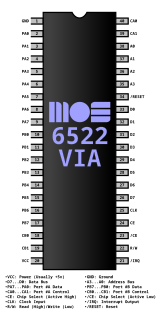 W
WA Peripheral Interface Adapter (PIA) is a peripheral integrated circuit providing parallel I/O interfacing for microprocessor systems.
 W
WThe 6522 Versatile Interface Adapter (VIA) is an integrated circuit that was designed and manufactured by MOS Technology as an I/O port controller for the 6502 family of microprocessors. It provides two bidirectional 8-bit parallel I/O ports, two 16-bit timers, and an 8-bit shift register for serial communications or data conversion between serial and parallel forms. The direction of each bit of the two I/O ports can be individually programmed. In addition to being manufactured by MOS Technology, the 6522 was second sourced by other companies including Rockwell and Synertek.
 W
WThe 6532 RAM-I/O-Timer (RIOT) was an integrated circuit made by MOS Technology, as well as second sources such as Rockwell. It incorporated 128 bytes of static RAM, two bidirectional 8-bit digital input/output ports, and a Programmable interval timer. This high degree of integration made it quite popular in the late 1970s and early 1980s, as it could take the place of several different integrated circuits (ICs).
 W
WThe Motorola 6845, or MC6845, was a display controller that was widely used in 8-bit computers during the 1980s. Originally intended for designs based on the Motorola 6800 CPU and given a related part number, it was more widely used alongside various other processors, and was most commonly found in machines based on the Zilog Z80 and MOS 6502.
 W
WThe 8563 Video Display Controller (VDC) was an integrated circuit produced by MOS Technology. It was used in the Commodore 128 (C128) computer to generate an 80-column RGB video display, running alongside a VIC-II which supported Commodore 64-compatible graphics. The DCR models of the C128 used the later and more technically advanced 8568 [D]VDC controller.
 W
WThe MOS Technology 8568 Video Display Controller (VDC) was the graphics processor responsible for the 80 column or RGBI display on D[CR] models of the Commodore 128 personal computer. In the Commodore 128 service manual, this part was referred to as the "80 column CRT controller." The 8568 embodied many of the features of the older 6545E monochrome CRT controller plus RGBI color.
 W
WThe 6526/8520 Complex Interface Adapter (CIA) was an integrated circuit made by MOS Technology. It served as an I/O port controller for the 6502 family of microprocessors, providing for parallel and serial I/O capabilities as well as timers and a Time-of-Day (TOD) clock. The device's most prominent use was in the Commodore 64 and Commodore 128(D), each of which included two CIA chips. The Commodore 1570 and Commodore 1571 floppy disk drives contained one CIA each. Furthermore, the Amiga home computers and the Commodore 1581 floppy disk drive employed a modified variant of the CIA circuit called 8520. 8520 is functionally equivalent to the 6526 except for the simplified TOD circuitry.
 W
WThe MOS Technology 6581/8580 SID is the built-in programmable sound generator chip of Commodore's CBM-II, Commodore 64, Commodore 128 and Commodore MAX Machine home computers. It was one of the first sound chips of its kind to be included in a home computer prior to the digital sound revolution.
 W
WThe 7360 Text Editing Device (TED) was an integrated circuit made by MOS Technology, Inc. It was a video chip that also contained sound generation hardware, DRAM refresh circuitry, interval timers, and keyboard input handling. It was designed for the Commodore Plus/4 and 16. Packaging consisted of a JEDEC-standard 48-pin DIP.
 W
WThe VIC , specifically known as the MOS Technology 6560 / 6561, is the integrated circuit chip responsible for generating video graphics and sound in the Commodore VIC-20 home computer. It was originally designed for applications such as low cost CRT terminals, biomedical monitors, control system displays and arcade or home video game consoles.
 W
WThe VIC-II, specifically known as the MOS Technology 6567/8562/8564, 6569/8565/8566 (PAL), is the microchip tasked with generating Y/C video signals and DRAM refresh signals in the Commodore 64 and C128 home computers.
 W
WThe Original Chip Set (OCS) is a chipset used in the earliest Commodore Amiga computers and defined the Amiga's graphics and sound capabilities. It was succeeded by the slightly improved Enhanced Chip Set (ECS) and greatly improved Advanced Graphics Architecture (AGA).